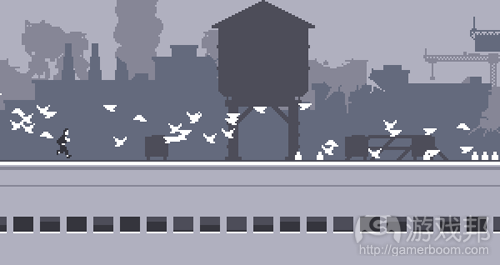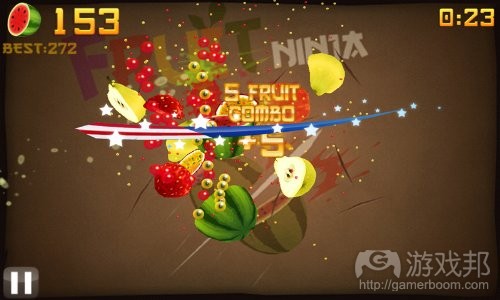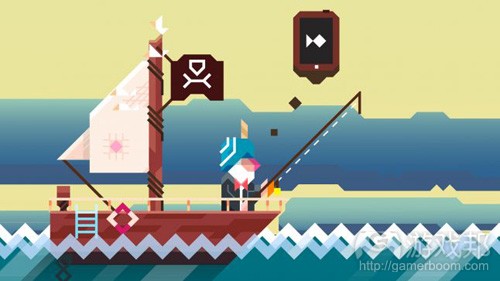分析具有商业可行性的手机游戏设计
作者:Ted Brown
我们在Eugene展开了一个Epic Oregon Game Jam活动,宗旨是专注于发现具有可行性的游戏原型。今年我们关注的是手机游戏。
我们的许多参与者是学生或者业余开发者,我撰写本文的目的就是为了与他们分享我无法亲自说明的详细内容,先从界面开始哟。长话短说,有趣的机制会吸引你的注意,但是业余水平的游戏,就没有任何优化或背景故事能够拯救你平庸的游戏了。
这对新人设计师来说并不是什么鼓舞人心的话,我也能理解其中原因。将“主观卓越性”替换成“商业可行性”可以令人感受到恐怖的竞争压迫感,并迫使他们直面应用商店每天都会冒出成百上千款新游戏这一现实。
这一般会产生两种反应:
1)没关系,我的游戏也可能会在嘈杂中消声匿迹。
2)我知道了!我打赌它们多半是垃圾。
没错,这一领域总是很“热闹”,但许多人提交的游戏却极为平庸。这就导致大量超出平均水准的新游戏每天都在竞争用户关注度,而真正出众的游戏却经常沦为市场上的炮灰。
今天的应用商店好比是90年代的Gamestop,但却不乏关于《半条命》和《古墓丽影》等蹩脚的共享软件。不要向应用商店发布蹩脚共享软件。也不要瞄准AAA质量的游戏。手机尽管功能强大,也并非主机设备。关键在于找到适合平台的内容。这样当你从界面入手时,就更可能命中目标。
但“商业可行性”究竟意味着什么 ?这个问题可能要从多个角度入手,包括营销和盈利,但设计师应该关注的是:
具有商业可行性的移动设计要使用简单、可扩展、重复性的机制,可以让用户以数分钟甚至更短的时间体验。
以我个人经验来看,新人设计师通常会排斥简洁性的概念,并通常偏爱系统甚于机制。认为《口袋妖怪》胜过《马里奥》,喜欢《天际》多于《猎天使魔女》。前者是一道平凡的自助餐,但却乏美味的小菜,而后者则使用了单一,但却能够与现实的食材完美融合的可口食谱(游戏邦注:例如关卡设计、敌人设计、能量提升等)。
我们很难制作一个能够让人永远享受其中的食谱,而这正是手机游戏设计师的职责。让我们看看一些通过关注其输入方法而示例了这一原理的游戏吧。
1.点触控制:《Canabalt》
新游戏题材并不常见,但Adam Saltzman的《Canabalt》却实现了这一点,有效衍生出无限奔跑这一题材。其中孤独的人物在屋顶上随机生成的世界不停地奔跑,他只响应一种输入方式:点触屏幕,这就是所谓的跳跃按钮。其要点在于你能跑多远就跑多远。这款游戏的成功之处在于回应了玩家想要全盘控制角色行动从而获得乐趣的这种需求。这种设计也为许多试图模拟NES屏幕控制器,但却徒劳无获的行为划下了句号。
我们可以找到不少关于一键按钮设计的文章,以及关于这种主题的游戏竞赛和活动。如果你觉得单个按钮无法驾驶一款游戏,看看关于这个话题的文章也许会改变你的看法,并“接受”高效情境式控制的理念。
2.划动屏幕:《水果忍者》
也许你会对此不悄,但《水果忍者》的安装量远比你的游戏要高,并且人们也确实喜欢这款游戏。没错,它是一款关于“干掉”水果的游戏,但其卖点却在于其游戏世界如何响应你的手指操作。这正也是为何多数人玩游戏的原因——他们不是为故事而来,也不是为精美的复杂度。他们玩游戏只是因为游戏让他们发笑,只是因为他们想放松片刻,只是因为他们想获得控制权。不要试图追求“深度设计”并导致你的玩家产生分析麻痹。要给予他们一个明确的目标,让他们找到实现该目标的简单方法,给他们一个清晰的反馈,这样就够了。
在《无尽之剑》问世时,划动控制再次迎来了新生机。要注意其中的相似之处:这种划动模拟的是空间实体对象的移动。这在《愤怒的小鸟》、《宝石迷阵》、《神庙逃亡》、《Osmos》以及许多游戏中也随处可见。划动屏幕实属移动设备的“本地语言”。
3.手势控制:《航空指挥官》
如果说有哪种游戏设计似乎一直很奏效,那就是“给人们一个可掌握的东西,当他们掌握时,给予更多目标”。《航空指挥官》就是这方面的绝佳例子。在这款App Store早期成功之作中,玩家可以在飞机你准备着陆时指引飞机的航线,尽量让它们在着陆时避免碰撞。这种玩法令人们爱不释手。不要忘了这其中的利益:没有人会指望能够从这种游戏中获得价值60美元的游戏玩法。要让游戏具有商业可行性,你得兼顾制作成本和潜在收益的问题。
也许是因为手势操作更适用于2D场景,所以我无法举出更多依靠这种机制的新游戏。这是不是一种由于持续划动的物理局限性而走向穷途的设计呢?还是说只是因为人们还没有发现扩大其空间的正确手法?
4.倾斜控制:《Ridiculous Fishing》
我认为《Ridiculous Fishing》的对角对齐式屏幕颇具游戏设计示范意义。它采用了稳定的压力/放松节奏,改变体验而非简单增加数量的升级,精心设计的进程,以及足够的精美元素令游戏呈现幽默、虚构式的基础。如果你还没玩过这款游戏,不妨去试试。
当你垂落或升提鱼钩时就要运用到倾斜控制。它很流畅和有效,它可以像划动或拖拽一样管用——鱼钩只是左右移动,但把手指放在屏幕上会阻挡你的视线(这一点很关键),并且会同其他使用于屏幕的输入方式混淆起来。其模拟感还增加了玩游戏时的一般物理感。
《Ridiculous Fishing》还示例了如何自然连接“微小趣味”活动从而实现深度的做法。它们本身无法支撑游戏,但结合在一起,就可以发挥魔力。
总结
本文还只是初级内容,这一领域还有许多需要挖掘的空间。在特定对角上的点触、拖拽、多点触、放大和缩小、GPS……移动设备上还有许多输入方式可利用。如果你想最大化游戏商业可行性,不妨选择其中一两者并将其发挥到极致。
要认识到未来很可能掌握在你手中或口袋中。你越早挖掘这一设备的无法回答,而不仅仅将其作为电脑或主机的模拟物,你就可能越早获得成功。(本文为游戏邦/gamerboom.com编译,拒绝任何不保留版权的转载,如需转载请联系:游戏邦)
Commercially Viable Design on Mobile
by Ted Brown
The following blog post, unless otherwise noted, was written by a member of Gamasutra’s community.
The thoughts and opinions expressed are those of the writer and not Gamasutra or its parent company.
Here in Eugene, we are ramping up for the inaugural Epic Oregon Game Jam, which is focused on discovering viable game prototypes. This year, the focus is on mobile titles.
Many of our attendees are students or amateur developers, and I’ve written this to tell them what I could not tell them all in person, in detail: start with the interface. Keep it simple and short. A fun mechanic will get you traction, but at the amateur level, no amount of polish or backstory will save a bland game.
This isn’t always heartening to new designers, and I think I understand why. To talk about “commercial viability” instead of “subjective goodness” raises the specter of overwhelming competition, and forces them to face the fact that hundreds of games launch each day on app stores.
This tends to prompt one of two reactions:
1) Nevermind. My game will probably be lost in the noise.
2) I got this! I bet most of them are crap.
It’s true that there is a lot of “noise” out there, but many of the submissions are just plain terrible. That leaves a handful of above-average new games that are competing for shares of attention each day, while a truly great game drops in and crushes the market much less often.
Today’s app market is like Gamestop in the 90′s, but where crappy shareware sits next to Half-Life and Tomb Raider. Don’t post crappy shareware to the app store. Don’t aim for AAA quality, either: the phone is not a console, despite its power. The key is to find what fits the platform. And when you start with the interface, you’re much more likely to hit the mark.
But what does that mean, really, to be “commercially viable”? Know that there are many perspectives on this question, including marketing and monetization, but the designer needs to focus on this:
Commercially viable mobile designs use a simple, extensible, repeatable mechanic that plays out in sessions measured in minutes or less.
In my experience, new designers are quick to rebel against the concept of simplicity, and are often more in love with systems than mechanics. Think Pokemon over Mario, or Skyrim over Bayonetta. The former are a buffet of generic but tasty dishes, while the latter use single, delicious recipe that can be adapted to the ingredients at hand (e.g. level design, enemy design, power-ups, etc).
It is hard to make a recipe you can enjoy over and over again, but that’s the job of a mobile designer. Let’s look at some titles that exemplify this philosophy by focusing on their input method.
1. The Tap : Canabalt
New genres aren’t invented very often, but Adam Saltzman’s Canabalt achieved just that when it effectively spawned the Infinite Runner genre. A lone figure races across the rooftops of a randomly generated world, responding to only a single input: the tap of the screen, which is treated as jump button. The point is to go as far as you can. The end. Canabalt’s success put paid the argument that player’s needed full control over a character’s motion to have fun. This (thankfully) ended a lot of the fruitless efforts to design effective on-screen controllers that could mimic something as simple as the NES.
There have been several articles on one-button design, as well as game jams and competitions around the theme. If you don’t feel a single button can carry a game, reading up on the topic will change your mind, and “incept” the idea of highly effective contextual controls.
2. The Swipe – Fruit Ninja
Laugh if you want, but Fruit Ninja has more installs than your game does. And people enjoy it. Yes, it’s a game about killing fruit, but the takeaway is how satisfying it is to have the world react to your touch likes it’s the blazing finger of God. THAT is why most people play games: not for your story, not for your beautiful complexity, and most especially not for your kitchen-sink method of Anything Goes game actions. They are playing games because they want to smile, because they want a break, because they want to be in control. Don’t try for “design depth” and end up giving your players analysis paralysis. Give them a clear goal, give them a simple way to achieve that goal, give them fantastic feedback, and stop there. It might be enough.
Swipe controls received another burst of energy when Infinity Blade hit the scene. Note the similarities here: the swipe mimics the motion of a physical object in space. It’s seen in Angry Birds, Bejewelled, Temple Run, Osmos, and countless more. Swipes really are the “native language” of mobile devices.
3. The Gesture – Flight Control
If there’s one game design recipe that seems to work over and over again, it’s “Give people one thing to achieve. When they master that, give them more.” Flight Control is a great example of this. An early success on the App store, you trace paths for planes to follow as they try to land, doing your best to keep them from colliding. Once again, “that’s it,” and yet people couldn’t stop playing. And don’t forget what the stakes are here: nobody’s asking for $60 of value from these titles. To be commercially viable, you have to take into account production cost as well as potential revenue.
Perhaps because gestures translate better to 2D space than 3D, I couldn’t come up with many new titles that rely on gesture mechanics. Is it a design dead end, due to the physical limitations of constantly swiping? Or has someone just not discovered the right metaphor to crack it wide open?
4. The Tilt – Ridiculous Fishing
I believe that Ridiculous Fishing hides a textbook on game design beneath its diagonally-aligned screens. A steady tempo of pressure / release, upgrades that change the experience instead of simply increasing numbers, beautifully scheduled progression, and enough filagree elements to give the game a humorous, fictional foundation. If you haven’t played it yet, do so.
The tilt input is used when dropping or raising the hook. Smooth and effective, it is punctuated by the general tap of drilling through fish that sit in your way, and then effectively counterbalanced by the frenetic tapping which follows a successful catch. It would have worked as a swipe or drag — the hook just moves left and right, after all — but having your finger on the screen obscures your view (which is important), and would have complicated other gestures that use the screen as their input. Its analog feel also adds to the general physical sensation of playing the game.
Ridiculous Fishing also exemplifies how depth can be achieved by naturally linking “small fun” activities. They can’t support a game on their own, but when bound together, there’s magic there.
Wrapping Up
This is only a primer: there is far more out there. Touches on specific objects, dragging, multi-touch, pinch and zoom, GPS… there are many inputs native to mobile devices. If you want to maximize your chances at being commercially viable, pick a few and exploit them to their fullest.
It’s important to recognize that the future is, most likely, in your hands or pocket. The sooner you can accept it for what it can do, instead of using it as a poor analogue for computers and consoles, the sooner you’ll find success.(source:gamasutra)











































 闽公网安备35020302001549号
闽公网安备35020302001549号